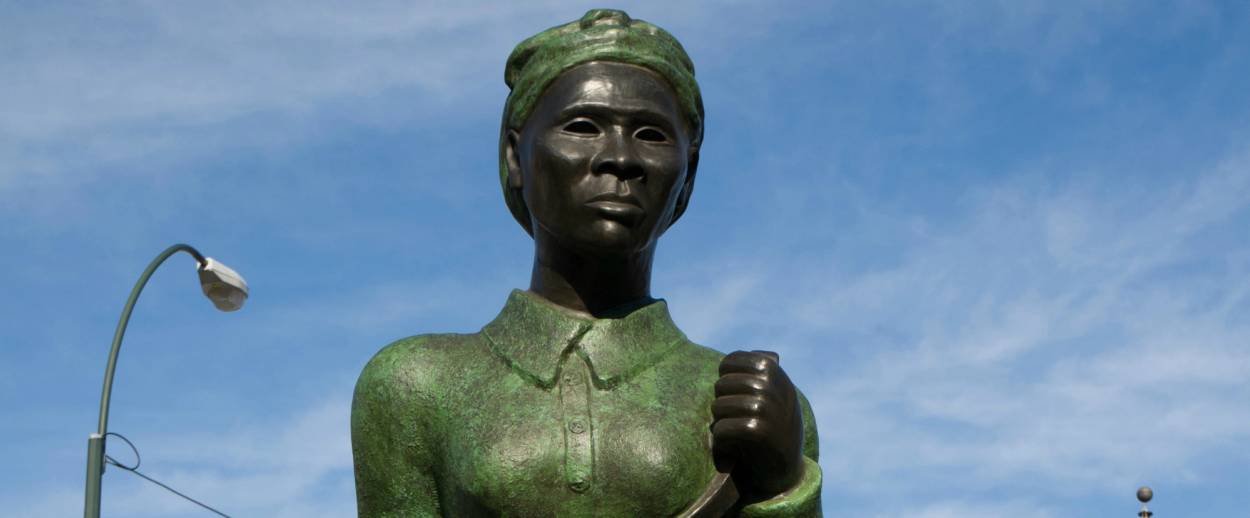This Passover, It’s Fitting to Honor Harriet Tubman, The Anti-Slavery Hero Who Was Known as ‘Moses’
The captain of the Underground Railroad couldn’t have been placed on the $20 bill at a more auspicious moment




Between 1852 and 1863, a former slave in her thirties, based in the North after her 1849 escape, made more than a dozen forays into the slave states of Maryland and Virginia to free other slaves. She was born Araminta Ross in Maryland. Her grandmother, Modesty, had been captured in Africa and shipped to the New World. In her early twenties, Araminta married a free black man named John Tubman. When she decided to escape slavery in Maryland, she took her mother’s name, Harriet. She became a “conductor”—a guide—in the Underground Railroad, the network of routes, guides, and safe-houses that conducted slaves northward toward to Canada.
According to my historian colleague Eric Foner, the most recent chronicler of the Underground Railroad, she was dubbed “Captain Harriet Tubman” by New York City’s leader of the American Anti-Slavery Society. But she was known to her abolitionist colleagues as Moses. That was also the name of her youngest sibling, one of eight.
It’s well established that the spirit of Moses was a constant companion to African America. Exodus was their liberation saga. This freedom story was common currency for slaves who, like Tubman herself, were illiterate. During rescue missions into the South, Tubman would sing a lyric about the Exodus (Moses go down in Egypt/Till ole Pharo’ let me go), as a warning, curiously enough, to potential escapees nearby; if those were the words she sang, she was signaling danger.
The inspiration of the Hebrews sometimes extended as far as the concept of a “chosen people.” In 1877, the Pan-Africanist Episcopal priest Alexander Crummell, in a sermon on “The Destined Superiority of the Negro,” wrote:
In a sense, not equal, indeed, to the case of the Jews, but parallel, in a lower degree … a people [trained and disciplined by God] are a “chosen people” of the Lord. There is, so to speak, a covenant relation which God has established between Himself and them: dim and partial, at first, in its manifestations, nut which is sure to come to the sight of men and angels, clear, distinct, and luminous.
Harriet Tubman will be the first African-American and the first woman to have her image cast on the front of a currency note. It seems fitting for all sorts of reasons—a symbolic reparation. In 1855, her father, Ben, himself a stationmaster in the Underground Railroad, had been freed from bondage, but her mother was still enslaved, although by the terms of the owner’s grandfather’s will, she was to have been freed. Ben had to purchase his wife’s freedom. The cost was $20, the same denomination of the bill she will now appear on.
Harriet went on to run spy missions for the Union army in the South, including a gunboat expedition that freed more than 700 South Carolina slaves. After the Union won the war, Harriet was denied a veteran’s pension. (As a sort of consolation prize, she was eventually granted a pension as the widow of a Union veteran whom she married after the Civil War.) Frederick Douglass, like Tubman a refugee from slave Maryland, and a man who himself housed many refugees from the slave South, said of her:
Excepting John Brown—of sacred memory—I know of no one who has willingly encountered more perils and hardships to serve our enslaved people.
In 2008, when a bronze statue showing Tubman breaking her chains was installed in the small triangle composed by Frederick Douglass Boulevard, St. Nicholas Avenue, and 122nd Street in Harlem, there were objections that she was depicted facing South, toward slavery. The sculptor, Alison Saar, offered a rebuttal: “She’s best known for her sojourns north, but what is most impressive to me are her trips south, where she risked her own freedom.” Point taken, though purists may object that the broken chains behind her are then facing north. “Swing Low,” the statue is called. It is, by the way, one of only five public sculptures depicting women in all of New York City.
Go down, Moses.
Todd Gitlin (1943-2022), was a professor of journalism and sociology and chair of the Ph.D. program in Communications at Columbia University, and the author of among other books The Sixties: Years of Hope, Days of Rage; Occupy Nation: The Roots, the Spirit, and the Promise of Occupy Wall Street; and, with Liel Leibovitz, The Chosen Peoples: America, Israel, and the Ordeals of Divine Election.